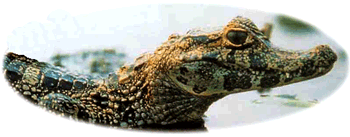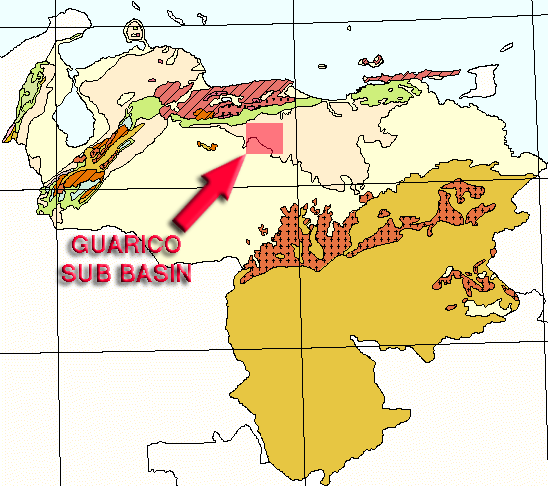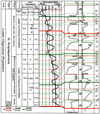
Introduction to well log character and shoreline clastics - Venezuela
Much of the un-referenced text below is copied and modified from John Reistroeffer's (2001) PhD Dissertation. Paul Lake, Eric Anderson and Nassir al Naji helped build the exercises from John Reistroeffer's data set. Errors are those of Christopher Kendall (alias "Retorno al Futuro") who ascribes to John's positive credo that "the sky is the limit"!
The exercises that follow introduce the interpretation of the sequence stratigraphy of an area using the electric logs. These logs are from a series of wells drilled in the shoreline clastics of the Mesozoic and Tertiary section of the northern Cratonic margin of Eastern Venezuela in the Western Guarico sub-basin. The focus of the exercises are wells that penetrate the Lower Oligocene La Pascua Formation. Since this formation does not outcrop, its lithology and sedimentary character are determined from E-logs and cores. The La Pascua Formation is an overall transgressive sandstone unit that contains the major hydrocarbon reservoirs for the region which have produced some 135 million barrels of oil and 686 billion cubic feet of gas (Reistroeffer, 2001). The exercises use electric logs to first identify and correlate a series of stratigraphic surfaces. These include transgressive surfaces-TS, maximum flooding surfaces-MFS and sequence boundaries-SB. From these the stacking patterns of the enclosed parasequences are established and used to determine the depositional setting of this formation.

Figure 1: Generalized geologic map of Venezuela showing the location of the Western Guarico block and the chosen study area. (www.geology.about.com/library/bl/maps/blvenezuelamap.htm)
Figure 2. Key to the generalized geologic map of Venezuela (figure 1 above) (www.geology.about.com/library/bl/maps/blvenezuelamap.htm)
The Eastern Venezuela Basin is formed of a series of Late Eocene to recent foreland basins located between the Guayana Shield to the South, and mountain chains associated with the Caribbean-South American plate to the north. The Caribbean-South American plate margin became active in the late Cretaceous when the Caribbean plate moved eastwards along the northwest margin of South America (Burke et. al 1984, Lugo, 1994, Audemard et. Al. 1985, Bartok, 1993). This eastward movement relative to and past the South American plate resulted in compressional to transpressional deformation along the interface between the plates. The thickest sedimentary packages of these asymmetric basins are located in the domain of maximum subsidence along an axis parallel and adjacent to the mountain front. Sediments thin in a southerly direction away from this axis. The Western Guarico sub- basin, the site of the well log exercises, is one of these basins and the basin surface changes into a gently dipping zone of low subsidence and sedimentation rates and the Craton forms the southern margin of the basin dips north towards the basin axis.
The sediments of the La Pascua Formation accumulated during a transgression in the Tertiary, and onlap onto the underlying Cretaceous Tigre Formation. The area of study is part of the Western Guarico Block (Figures 1, 2, 3 and 4).
Figure 3  Figure 4
Figure 4 
La Pascua Formation - Origin of the Oligocene cycles
Reistroeffer (2001) described the La Pascua section used in these exercises as corresponding to a third order Lower Oligocene sequence which lasted slightly more than one million years. He believed that this sequence is composed of ten fourth order sequences that each lasted about 125 thousand years. He noted how high frequency Oligocene sequences is also found to the east in the same age sediments of the Los Jabillos Formation (Personal Communication to Reistroeffer from Gerald Baum). In the east in the northern Monagas area Genaro Gifuni (1996) identified low and high frequency sequences in the Upper Oligocene Naricual Formation. The Rupelian aged Boom clay of Belgium is also composed of Rocks that are interpreted to have accumulated over a series of100,000 year cycles and Abreu and Haddad's (1998) unsmoothed oxygen isotope curve has high frequency "noise" with a similar cyclicity. These latter authors attribute high frequency cyclicity of the Boom clay to Milankovich cycles and attribute the driver to something similar to the third order cyclicity seen in the Antarctic deep sea drilling cores glacial cycles. Hanners (1974) also attributed la Pascua Formation cyclicity to Milankovitch cycles. Thus together the thread that ties these different Oligocene sections together is interpreted by Reistroeffer (2001) to be the fourth order cycles, attributed to Milankovitch driven glacial cycles, and their superposition on third order cycles
as in Figure 5. 
La Pascua Formation - General Description
As indicated above the La Pascua Formation is confined to the subsurface. It was first formally described by Hedberg (1950) but was informally used by the SAPLM in their early exploration of the Las Mercedes area. It was later described in detail by Patterson and Wilson (1953) and they designated the type section as the Guayabo-2 well in the southeastern quadrant of the study area.
The La Pascua Formation is approximately 500 feet thick in the Las Mercedes field area. Approximately 300 feet of this is net sand, and 200 feet is shale. Eight principle sands were labeled by Sociedad Anonima Petrolera Las Mercedes (SAPLM) from youngest to oldest as "A", "B", "BB", "C", "D", "E", "F", and "G" (Figure 5 thumbnail above). This correlation was changed by John Desisto working for Meneven in 1977 to be nine sand bodies ("P-1" through "P-9") from youngest to oldest. The exercises below Reistroeffers 2001 nomenclature, expanding on that of Desisto by identifying eleven sand units that included P-1 through P-11 (Figure 5 thumbnail above). The difference is reflected with two additional sands in SAPLM's "F" series, and an additional transgressive unit which pinches out at the level of the lower "G" sand.
The sands of the La Pascua Formation are grey to grey-brown and range in average grain size from very fine to very coarse with some conglomeratic intervals containing cobble-sized material (Patterson and Wilson, 1953). Total silt and clay content in the better developed sands varies from 4.6-13% (Perko, 1952). Overall the sands have fair to good sorting. Sieve analysis shows a tendency towards finer grain size at and above the level of the "D" sands (P-5) (Perko, 1952). kaolinite is often present in the sands ranging from point occurrences to thin layers. Often the fines are associated with production problems. This material is interpreted to be weathered remnants of feldspars derived from granites of the Guyana shield and the El Baul arch.
The shale layers that separate the sandstone bodies are black to grey-black, massive to finely laminated, calcareous to non-calcareous, with occasional pyrite grains and thin layers of lignite. Lignites and lignitic shales are common in the section, and, where they have been cored, reach four feet in thickness. These are commonly found near the top of each sandstone interval. Typical fossils include mollusk and mollusk fragments, which are often found in the sand bodies. Plant impressions and remains are commonly found within the levels of the lignite and lignitic shales. Foraminifera are found in the shales between the sand bodies (Patterson and Wilson, 1953).
The heavy minerals of the La Pascua Formation are dominated by titanium minerals of which leucocene (weathered illmenite) usually makes up more than half of the heavy concentrates, along with smaller amounts of anatase, rutile, titanite, and brookite. The non-titanium minerals are dominated by zircon, with scattered occurrences of tourmaline. Scattered single-grain occurrences of staurolite, hornblende, augite, epidote and hypersthene are also present (Perko, 1952). The La Pascua Formation sands in the West Guarico block have a similar heavy mineral suite to the Merecure Group sands, as discussed by Funkhouser et. al. (1948) as having been derived from the Guyana Shield.
The La Pascua Formation is overlain by the regional transgressive Roblecito Formation, a marine facies which has a proximal La Pascua sandy equivalent. The original definition of the La Pascua Formation only included the sandy intervals found in the Las Mercedes field area. However this name has come to represent the basal sandstone units of the regional Upper Eocene-Lower Oligocene transgression. The sandstone levels at and above the "D" sands (P-5) in the Western Guarico block are represented by shales to the northwest in the Grico, Camaz, and El Sombrero areas. Sandstone levels in the north and northwest are older, while successively younger units pinchout southeastward. Basal sandstones to the south, in the Machete area of the heavy oil belt, are the lateral equivalents to marine shales of the Roblecito Formation, which overlie the Western Guarico Block.
Sandstones in the La Pascua Formation are derived from three primary sources. The lower units ("G" and "F" SAPLM nomenclature, or P-7, P-8, P-9 Desisto nomenclature or P-7, P-8, P-9, P-10, P-11, these exercises) are all derived from a southern source in the Precambrian Roraima Formation of the Guyana shield south of the area of the exercises. Sands in the upper La Pascua Formation at and above the "D" sands (the P-5 sands of Desisto and these exercises) in the Western Guarico Block are also derived from the southern Guyana shield source. Upper La Pascua Formation sands north of the study area in Yucal-Placer, Macaira, Uveral and Cardonal are derived from a northern source, probably eroded material from an encroaching northern thrust front (Aymard et. al., 1985, Daal et. al. 1989). Between the area of the exercies and the above-mentioned areas to the north, exists a zone with minimum sandstone present in the La Pascua Formation. This area is the axis of the La Pascua aged basin, which separates the zone of southern-sourced clastics from the zone of northern-sourced sediments (Patterson and Wilson et. al. 1953, Fasola et. al., 1985 and Cabrera et. al., 1994). In addition, the presence of kaolinite in the sands opens the possibility that at least some of the clastics are derived from the El Baul arch.
The upper contact with the Roblecito Formation is transitional and conformable. It corresponds to the top of the uppermost sand-body in the Guayabo-2 well in the study area. The contact in the northwest which corresponds to an electric log marker at the base of the Roblecito shales, does not represent a lithologic change, since the upper La Pascua section is mostly shale. Likewise; to the northeast of the study area, the contact is marked by an electric log marker at the top of the sandy La Pascua Formation interval but does not represent a lithologic break, since the Lower Roblecito Formation is also quite sandy.
The Lower contact with the Cretaceous El Tigre Formation is unconformable, and the La Pascua sands overlie progressively older sediments in a southwesterly direction until they rest unconformably on the Paleozoics of the Barbasco Group, the El Baul granite and the Guacamaya Volcanics, southwest of the town of El Calabozo (Miller and Martinez, 1972, Patterson and Wilson, 1953).
The contact between the basal La Pascua and the Cretaceous was extensively cored by SAPLM. The unconformity is easy to determine in cored sections but is often less obvious from cuttings and E-logs. Cores show poorly-sorted sandstones and conglomerates ranging in grain size from fine to pebble sized. Geode-like silica concretions, chert grains and pebbles considered to be reworked Cretaceous sediments are common. kaolinite occurs in small pockets which represent the weathered remains of feldspar crystals. Occasional lignites and lignite streaks are found in the lower La Pascua sandstone. Dr. L. V. Illing et. al. in a 1953 internal report describes the pebbles in the basal Tertiary unit as follows:
"... well rounded all sizes up to 3" across: the dominant size is estimated at one half to three quarters inch in diameter. The principle (pebble type) .... white porcelaneous chert with a slightly powdery texture and often with roughly cuboidal fractures. Some pebbles show a darker core. The white color is due to a very finely porous texture, and is clearly due to alteration, presumably weathering. By soaking in clove oil, the chert becomes translucent or transparent, and shows small inclusions and occasional foraminifera. Some pebbles are very rich in foraminifera, including abundant Textularia(?), some Globigerina and many other pelagic forms. The chert is devitrified and shows as a plexus of tiny crystallites under cross-nicols. Occasionally, it shows a spherulitic devitrification. Rare pebbles of fresh chert occur"
The Underlying Cretaceous has blue-grey fish remains, rodlike tan fecal pellets, foraminiferal chert, isolated secondary dolomite rhombs and finely banded siliceous argillite. Occurrences of black translucent chert have abundant inclusions of foraminifera including spherical cells, Textularia and Globigerina. Occasional veins of opaque white and clear blue chert occur, the white color is probably due to weathering similar to the weathering that occurs in the La Pascua Formation cores (Illing et. al., 1953).
The La Pascua Formation, in wells adjacent to the southern margin of the mountain front in the northern Guarico area, is Lower Oligocene in age, based on the presence of the planktonic foraminifera zones of Cassigerinella chipolensis/Pseudohastigerina micra and Globigerina ampliapertura (Fasola et. al., 1985).
The next Section describes the first steps in the use of well logs to build sequences stratigraphic models of clastic shoreline depositional systems for the Lower Oligocene La Pascua Formation of the Las Mercedes Field in the West Guarico Block, Venezuela.